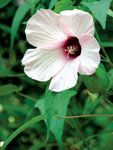A one-day flower with a two-day appeal
Originally published August 28, 2008

Halberd-leaved swamp mallow remains fully open for one day. Photo by Ken Moore
Ken Moore
Locally we frequently spot the common white-flowered, swamp mallow, Hibiscus moscheutos, growing in wet depressions and along the edges of Jordan Lake. Fortunately, they have numerous buds, for each flower remains open for only one day. However, in my opinion there’s a finer wild hibiscus out there, but you’ll have to go further afield to find it. This one sports a rose-pink flower with a two-day appeal.
I first saw it decades ago on the bank of the Neuse River at the Kinston bridge. DOT improvements have eliminated that population, but not before I had collected seed. Like the common swamp mallow, this rose-colored hibiscus, Hibiscus militaris, a halberd-leaved swamp mallow, is worthy of cultivation. I now have several plants on the edge of my little backyard wetland. Though naturally occurring in wet areas, wild hibiscus species are easily cultivated in the garden if a little water is added during droughts.
Realizing how descriptive plant names can be, I’m a bit amused with the species designation, militaris, which means “like a soldier.†This particular swamp mallow does stand rather stiffly erect, like a soldier at attention. Perhaps more obviously descriptive is the common name, halberd-leaved, which refers to the medieval axe-like weapon, which one’s imagination may relate to the narrow triangular leaf with distinct lateral lobes at the base. Once you see that characteristic leaf, you most likely will remember it.
You rarely see the halberd-leaved swamp mallow in the wild and very few gardeners cultivate it.
So when I saw hundreds of plants this past week down east growing along the edge of the Black River, it was as exciting as seeing the 2000-year-old cypress trees. The natural distribution of this hibiscus seems to be along a narrow corridor of swamps and rivers just inland of where salt-water tidal action bears influence. My limited observations have always found them standing “soldier tall†along river edges in one to two feet of water. One explanation for the visible scarcity of these plants may be that seeds can only germinate on exposed riverbank soil during periods of very low water. That means those seeds have to be quick to germinate and seedlings must mature before the return to normal water levels.
For me, the most appealing characteristic is the plant’s habit of hanging onto each spent flower for a second day. The pendulous deep-pink tubular flower of the second day seems completely unrelated to the wide-open pinwheel flower of the first day. The cylindrical twisting of the day-old flower is most likely the plant’s strategy for insuring self pollination if the preferred insect cross pollination of the open flower does not occur on the previous day. Better to have self pollination rather than no pollination at all. Some plants are like that. There is much to contemplate when looking at a flower.
If you travel east during the upcoming Labor Day weekend, keep your eyes alert when driving over rivers and seek out walking trails through swamps and along coastal rivers for a chance spotting of these tall, pink-flowered mallows.


Comments are closed.